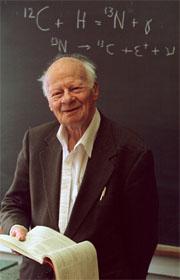 Hans Bethe in 1996, in front of his famous carbon-oxygen-nitrogen cycle equation.© 1996 Michael Okoniewski
Hans Bethe in 1996, in front of his famous carbon-oxygen-nitrogen cycle equation.© 1996 Michael OkoniewskiNobel laureate Hans Bethe, who played a key role in designing the first atomic bomb and worked out how stars generate their energy, died on Sunday 6 March, aged 98.
Bethe had been a professor of physics at Cornell University, Ithaca, New York, since 1935. "Hans Bethe was a giant of twentieth-century science," says Robert Richardson, Cornell's vice-provost for research. "He has been revered by his Cornell colleagues."
Bethe was born in Strasbourg, then part of Germany (now France), on 2 July 1906. After training in physics, he fled to England in October 1933 to escape the Nazi regime. After brief spells at the universities of Manchester and Bristol, he moved to Cornell in 1935.
“Hans Bethe was a giant of 20th century science.”
Robert Richardson
Cornell University, Ithaca, New York
Bethe's work on nuclear reactions led him to discover in 1938 how the brightest stars generate their energy. Dubbed the 'carbon-oxygen-nitrogen' cycle, these elements sequentially acquire four hydrogen nuclei before releasing a helium nucleus and a burst of energy, with carbon atoms effectively acting as a catalyst.
Later, Bethe realized that smaller stars such as our own Sun are lit by the direct fusion of hydrogen nuclei. He was awarded a Nobel Prize for these discoveries in 1967, as well as for his work on nuclear physics in general.
Atomic education
During the Second World War, Bethe led the theoretical-physics division at the Los Alamos laboratory in New Mexico, which was home to the Manhattan Project to build the world's first atomic bomb. One of his team's key tasks was to work out the critical mass of uranium-235 necessary to sustain the fission reaction that would drive the bomb's explosive force.
ADVERTISEMENT
When he witnessed the detonation of the first nuclear explosion at the Trinity site in the New Mexico desert on 16 July 1945, Bethe professed concern only for the smooth running of the test, rather than the implications for the world. "I am not a philosopher," he explained.
But after the war, Bethe joined Albert Einstein on the Emergency Committee of Atomic Scientists, which aimed to educate the public about atomic energy. He later campaigned to restrict further research on nuclear weapons, and promoted the peaceful use of nuclear energy. He helped to persuade the White House to ban atmospheric nuclear tests in 1963 and antiballistic missile systems in 1972.
He is survived by his wife Rose, his son Henry and his daughter Monica.
Cornell University, Ithaca, New York
